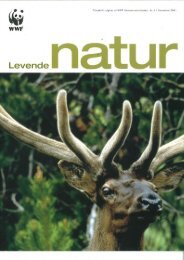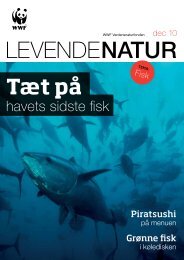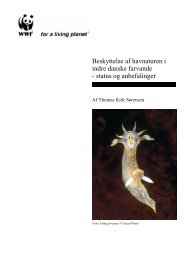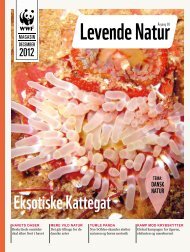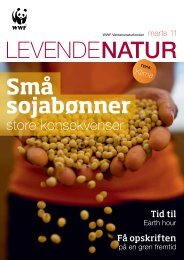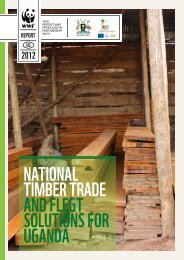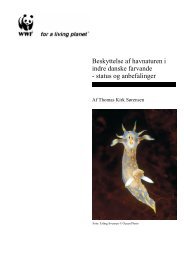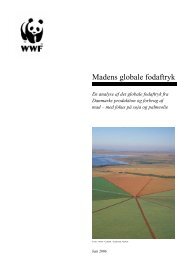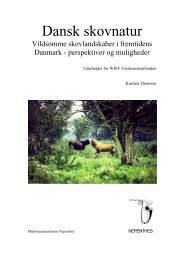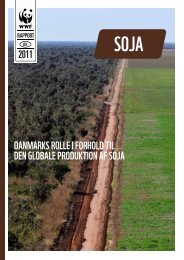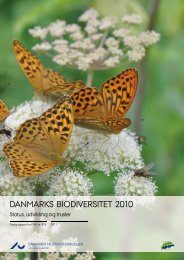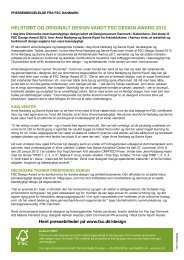About WWF-Tanzania
About WWF-Tanzania
About WWF-Tanzania
You also want an ePaper? Increase the reach of your titles
YUMPU automatically turns print PDFs into web optimized ePapers that Google loves.
<strong>WWF</strong> <strong>Tanzania</strong><br />
NEWSLETTER<br />
DECEMBER<br />
2012<br />
Whale shark feeding (ChrisRohner)<br />
Dear Readers,<br />
<strong>WWF</strong> - TANZANIA<br />
Welcome to our <strong>WWF</strong>-<strong>Tanzania</strong> Newsletter, in its end of the year edition!<br />
It has been a year full of challenges and a year that brought us so many good lessons. In the end, we<br />
manage to close the calendar year with good news from everywhere: we have new teams, new colleagues in<br />
place, we have new projects starting in January – for example, new funding for the marine programme from<br />
EU – and projects that were suspended are to re-open – the REDD and the strengthening of CSOs.<br />
It is time then that we celebrate this end of the year with renewed optimism but also being certain that a lot<br />
of work lies ahead of us. Our work needs more effort to overcome the remaining challenges ahead in order<br />
to reach all our targets which is our aim. And we need collaboration from all, being <strong>WWF</strong> staff, partners and<br />
supporters.<br />
In this issue of our Newsletter we look at our achievements in the last quarter of the calendar year. We<br />
will revise our support to small entrepreneurs through community based associations, farming towards<br />
sustainability of water reservoirs, Authorized Associations (AA) allocating hunting blocks to outfitters, the<br />
establishment of locally managed forest reserves in Rufiji, Lindi and Kilwa districts, and the conservation<br />
challenges facing one of the great wildlife wilderness areas in Africa - the Ruvuma Landscape.<br />
We shall also have a glance at the outreach support to wildlife conservation especially our commitment to<br />
anti-poaching activities and, finally, the research developments for Whale Sharks.<br />
I wish all of you a very pleasant Festive Season and a very great New Year of 2013!<br />
Helena Motta<br />
Rungwecebus Kipunji (Trevor Jones)
<strong>WWF</strong> <strong>Tanzania</strong><br />
2<br />
RESEARCH: Whale Shark<br />
Deploying an acoustictag (ChrisRohner)<br />
The whale shark season at Mafia Island is in full<br />
swing and the <strong>WWF</strong>-funded joint research study,<br />
which started last month in mid-October, has had<br />
a great start to field work that will continue into<br />
April 2013. It is being conducted by an international<br />
team of whale shark scientists from the Marine<br />
Megafauna Foundation, Mozambique, the King<br />
Abdullah University of Science and Technology,<br />
Saudi Arabia and the <strong>Tanzania</strong> Fisheries Research<br />
Institute. So far, 15 whale sharks have been tagged<br />
and a network of 18 acoustic listening stations<br />
deployed. These will record whenever one of the<br />
tagged sharks swims past, building up a picture<br />
of the sharks movements, which can later be<br />
analysed in relation to other environmental factors.<br />
The team has started to measure various<br />
oceanographic and climatic parameters, the<br />
results are already showing that sharks are mostly<br />
seen at the surface when they are feeding in<br />
dense patches of zooplankton - small, floating<br />
crustaceans.<br />
If the first 6 weeks are anything to go by the team<br />
will have an amazing and busy remainder of the<br />
whale shark season, which tails off in April. From<br />
May to September whale sharks, the world’s<br />
largest fish, are seldom seen.<br />
Removing Fishing hook from Tail (Fernando Cagua)
<strong>WWF</strong> <strong>Tanzania</strong><br />
FRESH<br />
WATER<br />
WOMEN IN<br />
TERRACE<br />
FARMING<br />
TOWARDS<br />
SUSTAINABILITY<br />
OF MABAYANI<br />
RESERVOUR<br />
Women participating in construction of the<br />
Terraces.<br />
Women participating in construction of the<br />
Terraces.<br />
3<br />
Communities in the Kimbo, Mashewa, Kwa Isaka, Shembekeza and Bombani villages<br />
have embarked into various land use practises to reduce sediments load into Mabayani<br />
reservoir. The interventions include bench terraces, rusha juu/chini, grass stripping<br />
and other soil and water conservation practices.<br />
In this regard, women have shown enthusiasm in taking up the challenge; they have<br />
committed their farms, work force as well as farming implements. In theory sessions<br />
where farmers have been provided with skills on how to implement the interventions,<br />
women were highly active and motivated.<br />
The interventions followed a number of specific studies (Hydrological and Livelihood studies) which have<br />
been conducted as part of preliminary project interventions in 2010 and 2011.<br />
The studies showed that sediment load in the Mabayani reservoir (which is the aftermath of farming in<br />
slopes) has been steady increasing from 2004 to 2010 (refer figure 3 below).<br />
Analysis has shown that the average depth of the reservoir has decreased by 3.3 m from 8.7 m at the<br />
time of filling the dam to 5.4 m at the time of the study (about 38% decrease).<br />
The reservoir capacity has decreased by 2.1 million m3 from 8 million m3 at the time of construction to<br />
5.9 million m3 at the time of carrying out the study which is 25% decreases (ACE Consulting Engineers,<br />
2010).<br />
This has seen an increment in expenditure by Tanga UWASA to de-sediment water from<br />
250,000,000Tsh in year 2005/2006 to 450,000,000Tsh in 2009/2010 (refer figure 4 below)<br />
As part of sustainable undertakings, Tanga UWASA who are in this case the buyers of the watershed<br />
services are drafting an MoU with catchment stewards (sellers) of the five riparian villages to establish a<br />
sustainable framework through which EPWS program will be implemented.<br />
Turbidity level at Mowe Treatment Plant reduce<br />
(Tanga – UWASA 2010)<br />
Prepared by;<br />
Onesmo Zakaraia (Freshwater Thematic Leader)<br />
Kanuni S. Kanuni (Field Officer)<br />
Brigitha Faustin ( Intern)<br />
<strong>WWF</strong> <strong>Tanzania</strong><br />
Tanga UWASA annual expenses to sediments<br />
(Source: Tanga UWASA 2010)
<strong>WWF</strong> <strong>Tanzania</strong><br />
CBNRM-WMAs<br />
Authorized Associations allocating<br />
hunting blocks to outfitters<br />
Unlike in the past, the Wildlife<br />
Conservation Act (WCA) of 2009 gives<br />
mandate to Authorized Associations<br />
(AAs) with hunting blocks in their areas<br />
to select and enter into agreement<br />
with outfitter(s) beginning 2013 – 2018<br />
hunting term. AAs can now invite<br />
applications for hunting blocks in their<br />
areas, review the applications, negotiate<br />
and sign contracts with selected<br />
outfitters.<br />
<strong>WWF</strong> working with Authorized<br />
Association Consortium (AAC) and<br />
other facilitating NGOs are building the<br />
capacity of AAs to manage the process<br />
of allocating their hunting blocks.<br />
In August this year, 12 WMAs issued<br />
advertisements inviting applications for<br />
18 hunting blocks in their areas as per<br />
WCA and associated regulations.<br />
Nine of the 12 WMAs received<br />
applications as follows:<br />
Burunge<br />
(1), Enduimet<br />
(2), Magingo<br />
CONFERENCE,<br />
WORKSHOPS<br />
<strong>WWF</strong> Africa POD,<br />
Health & Safety<br />
Conference<br />
In October (8th – 12th) 2012,<br />
<strong>WWF</strong>-<strong>Tanzania</strong> HR Team attended <strong>WWF</strong><br />
Africa POD Conference and Health &<br />
Safety Workshop in Naivasha, Kenya.<br />
4<br />
(3), Ikona<br />
(4), Makame<br />
(5), Makao<br />
(6), Tunduru<br />
(7), Mbomipa<br />
(8) and Jukumu<br />
(9). Ngarambe-Tapika,<br />
Ipole and Uyumbu did not receive<br />
applications and are considering readvertising.<br />
Mbarang’andu WMA did not<br />
advertise its hunting block.<br />
Even as this represents partial<br />
devolvement of decision making power<br />
related to WMA business operations, the<br />
development marks a major turning point<br />
in the history of hunting in <strong>Tanzania</strong> and<br />
a step in the right direction towards full<br />
empowerment of communities.<br />
The entire process of allocating hunting<br />
blocks in WMAs will need to be reexamined<br />
with the view to devolve<br />
more powers and responsibilities to<br />
communities to make it a truly community<br />
led process. Issues such as quota setting,<br />
pricing etc. are still centralized.<br />
The conference agenda covered<br />
issues such as HR Standards,<br />
HR Competencies, HR Policies &<br />
Procedures, Job Grading, Compensation<br />
AAs have little or no room to negotiate<br />
game fees, which deny them<br />
opportunities to realize market value for<br />
their animals. So, there is still a lot of<br />
ground to cover.<br />
<strong>WWF</strong> in collaboration with partners will<br />
continue to support AAs towards more<br />
meaningful decentralization so that WMAs<br />
can realize their full potential.<br />
Opening of applications for hunting block<br />
in Enduimet WMA. (Eliezer Sungusia)<br />
& Benefits, Crisis Management and<br />
Making the most of International SOS<br />
Medical and Security Service.
<strong>WWF</strong> <strong>Tanzania</strong><br />
RUMAKI SEASCAPE<br />
VICOBA the fuel of Small Business<br />
Monica Simbo in her Money Transfer shop with<br />
some products from her former business<br />
Mama Simbo Shop is a famous mobile<br />
money transfer based at Kilindoni on<br />
Mafia Island. The shop is operated by<br />
none other than Monica Simbo a member<br />
of Upendo VICOBA Group. She joined<br />
VICOBA in 2010 before that she was a<br />
clothes and shoe vendor.<br />
She has borrowed 3 times from the<br />
VICOBA and invested in the Money<br />
transfer business working with Tigo Pesa,<br />
Air Tel Money and Vodapesa.<br />
Her first loan was Tshs 1, 800,000 Second<br />
Tshs 2,500,000 and third Tshs 3,000,000<br />
She is currently running the business with<br />
a working capital of Tshs 8,000,000. This<br />
gives her an income of Tshs 800,000 per<br />
months. ’Though I am the most reliable<br />
money transfer shop in Mafia but my<br />
target by end of 2013 is to operate with<br />
a capital of Tshs 15,000,000 so that the<br />
shop does not run short of money for<br />
receiving and sending customers ’….Said<br />
Monica confidently.<br />
The ever busy Monica Simbo money transfer Shop<br />
World wildlife Conservation Day<br />
On the 4th December 2012 <strong>WWF</strong>-<br />
<strong>Tanzania</strong> joined hands with the U.S<br />
Embassy in <strong>Tanzania</strong> to commemorate<br />
the World Wildlife Conservation Day.<br />
Activities included screening of a WMA<br />
film followed by discussions and <strong>WWF</strong><br />
Communication material sharing with the<br />
invited guests, University and Secondary<br />
school students.<br />
5<br />
Mr Asukile Kajuni, CBNRM Deputy<br />
Programme Co-ordinator and Laura<br />
(Communication) from <strong>WWF</strong> - <strong>Tanzania</strong><br />
formed part of the discussion panel.<br />
Other than lessons sharing it is pleasant<br />
to note that the occasion provided us with<br />
another chance to push for <strong>WWF</strong> brand<br />
visibility with students learning more<br />
about <strong>WWF</strong>.<br />
<strong>WWF</strong> <strong>Tanzania</strong><br />
Through this business mama Simbo<br />
is supporting the family in terms of<br />
education, health and general up keep<br />
of the family. ‘I thank <strong>WWF</strong> RUMAKI for<br />
introducing the VICOBA scheme on the<br />
Island’ she concluded.<br />
Buffaloes in one of the open habitats in selou<br />
ecosystem (Cyprian Malima)
<strong>WWF</strong> <strong>Tanzania</strong><br />
Ruvuma Landscape<br />
Facing many conservation challenges ranging from anthropogenic<br />
development activities, annual fierce fires, poaching, climate change,<br />
unsustainable logging, oil and gas explorations/mining<br />
The Ruvuma Landscape, is a huge area<br />
of 280,000 square kilometres extending<br />
far either side of the Ruvuma River<br />
into both <strong>Tanzania</strong> and Mozambique.<br />
It stretches from the Rufiji River in the<br />
north to the Pemba-Lichinga road in the<br />
south; from Lake Nyasa in the west, all<br />
the way across to the Indian Ocean. The<br />
Ruvuma Landscape is a very important<br />
and special area. In one respect it is<br />
one of the last great wildlife wilderness<br />
areas in Africa. Populations of majestic<br />
elephants, lions, buffalo and many other<br />
species of large animals roam within and<br />
between the Selous and Niassa Game<br />
Reserves, via the wildlife corridors This<br />
is part of our natural heritage, an asset of<br />
incalculable value that if lost could never<br />
be restored, and which we therefore<br />
need to preserve. In another respect the<br />
Ruvuma Landscape is an area of great<br />
Rufiji landscape<br />
Demarcation of an enlarged Kichi Hills<br />
LAFR and the survey of proposed<br />
Village Land Forest Reserves has<br />
covered 31,677.19 ha within the Rufiji<br />
landscape. The vegetation ranges from<br />
coastal woodlands, riverine riparian<br />
coastal forests with good ecosystem and<br />
harbors much biodiversity. Participatory<br />
Forest Resource Assessment (PFRAs)<br />
for 5 proposed VLFRs and drafting of<br />
management plans and bylaws were<br />
completed. Approvals and declarations at<br />
village councils will be finalized by 2013.<br />
Kilwa landscape<br />
Demarcation of proposed VLFRs and<br />
LAFRs were completed and a total of<br />
79,806.7 ha was added to the reserved<br />
land in this District. These new areas are<br />
Mbarawala LAFRs (48,180 ha), Lung’ou<br />
VLFR (19,196 ha), Lupyagile VLFR<br />
(1,388 ha), Mirambani LAFR (9,397 ha),<br />
Kiwawa VLFR (993.27 ha) and Hotelitatu<br />
VLFR (1,546.45 ha).<br />
6<br />
economic potential, not least in terms<br />
of agriculture. The Ruvuma Landscape<br />
has enormous land resources which can<br />
support livelihoods and generate wealth<br />
both for communities and for farming<br />
businesses.<br />
There are also abundant energy sources<br />
such as hydropower in the Rufiji Basin<br />
and coal resources in Mbinga and<br />
Manyamba Districts. We have a diversity<br />
of mineral wealth including uranium,<br />
limestone, gemstones and iron. We have<br />
a growing tourism industry with great<br />
potential, especially in Selous and Niassa<br />
Game Reserves and on the shores of the<br />
beautiful Lake Nyasa.<br />
Most of this development potential<br />
has yet to be tapped, but several<br />
major programmes are under way, not<br />
Lindi landscape<br />
The demarcation of new proposed VLFR<br />
covering 13,577.29 ha were completed<br />
in this landscape. Participatory Forest<br />
Resource Assessments 2 villages<br />
were completed, management plans<br />
were drafted, and harvesting plans<br />
for five species were produced. The<br />
species concerned were the timber<br />
trees Afzelia quanzensis, Pterocarpus<br />
angolensis, Milicia excelsa, Albizia sp and<br />
‘Mtuganjiwa’.<br />
One of the expected outcomes from Lindi<br />
landscape is the upgrading of Rondo<br />
forest reserve into a Nature Reserve<br />
under central government management.<br />
The process for upgrading 14,000 ha<br />
of the current Rondo reserve started in<br />
2011, and the upgrading now has the<br />
approval and endorsement from village<br />
councils, District council and Regional<br />
authorities of Lindi and awaits national<br />
gazettement.<br />
In summary, the UNDP GEF funded<br />
Coastal forests project is focussing on<br />
the Protected Area sub system, and<br />
has been facilitating land use planning<br />
for demarcation of Village Land Forest<br />
Reserves (VLFRs) and Local Authority<br />
Forest Reserves (LAFRs). Since<br />
<strong>WWF</strong> <strong>Tanzania</strong><br />
least through two or three high profile<br />
agriculture and development corridor<br />
initiatives, such as SAGCOT, the Mtwara<br />
Development Corridor and the Pemba-<br />
Lichinga Corridor. However, the Ruvuma<br />
landscape is currently facing many<br />
conservation challenges ranging from<br />
anthropogenic development activities,<br />
annual fierce fires, poaching, climate<br />
change, unsustainable logging, oil and<br />
gas explorations/mining, etc. As a result<br />
the sustainability of Ruvuma landscape to<br />
support livelihood of the communities is at<br />
stake.<br />
<strong>WWF</strong> Staff and local communities admirering the<br />
scene of Mbarang’andu valey (Cyprian Malima)<br />
its inception, the project is working<br />
to develop community based forest<br />
management approaches in target<br />
villages on the margins of government<br />
protected Forest Reserves. These<br />
forest areas will allow local villagers<br />
to gain control over forest resources<br />
in their village lands and hence gain<br />
greater benefits from these resources.<br />
The benefits are planned to include<br />
the development of sustainable and<br />
certified forest products (FSC) from these<br />
forest areas. Advice and input to the<br />
development of the FSC certification and<br />
sales routes to Europe is being developed<br />
using co-financing from <strong>WWF</strong> Denmark,<br />
<strong>WWF</strong> <strong>Tanzania</strong>, Comic Relief (UK) and<br />
the Mpingo Conservation & Development<br />
Initiative<br />
Mangrove (David Hoyle)
7<br />
<strong>WWF</strong> <strong>Tanzania</strong><br />
Establishment of locally managed forest reserves<br />
in Rufiji, Lindi and Kilwa Districts<br />
Large areas of forest and woodland<br />
remain in southern <strong>Tanzania</strong>, and these<br />
areas have formed the focus of the<br />
current UNDP GEF investment into the<br />
development of the protected areas subsystem<br />
in <strong>Tanzania</strong>. The majority of the<br />
projects work has focused on working<br />
with communities on the declaration of<br />
village land forest reserves under their<br />
direct control, and in the improvement<br />
of management in local authority forest<br />
reserves and also in the Rondo forest in<br />
Lindi, which is one of the most important<br />
forests in terms of biodiversity along the<br />
Eastern African coast.<br />
As with many other projects in recent<br />
years, the UNDP GEF investment has<br />
adopted Participatory Forest Management<br />
as the main mechanism for project<br />
implementation, building from the<br />
guidance of the Forest Policy of 1998<br />
and the Forest Act of 2002 (see box 1).<br />
The main aim of Participatory Forest<br />
Management aims to village level forest<br />
reserves as a part of village land use<br />
planning, which is linked to efforts to give<br />
villagers control over their land, and allow<br />
local development activities to proceed<br />
(see Box 1).<br />
So far the project has<br />
facilitated the reservation of<br />
more than 133, 000 ha of<br />
forested land (coastal forest<br />
and miombo woodlands),<br />
with part of this being LAFRs<br />
under the District Council<br />
(56,056 ha) and the majority<br />
(77,521 ha) are VLFRs under<br />
the village (Table 1).<br />
Box 1.<br />
The 1998 <strong>Tanzania</strong>n Forest Policy promoted, for the first time in this country,<br />
community participation in forest conservation and management and created the legal<br />
space for village governments to protect hitherto unreserved forest within their area<br />
of jurisdiction through the establishment of Village Land Forest Reserves (VLFR),<br />
which are owned and managed by village governments under a system known as<br />
Community Based Forest Management (CBFM).<br />
The goals of the 1998 Forest Policy were later embedded in law through the Forest<br />
Act No. 14 of 2002 [Cap 323 R.E. 2002] (URT 2002), and in regulations and guidelines<br />
for CBFM (MNRT 2003). These make explicit reference to the development of forest<br />
management by-laws by Village Councils through the legal provisions provided for<br />
under the Local Government Act No. 7 of 1982 (URT 1982).<br />
The Forest Act stipulates that The Village Councils can delegate the responsibility of<br />
forest management to Village Forest Committees, which are now generally known<br />
as either Village Environmental Committees (VECs) or Village Natural Resources<br />
Committees (VNRCs). These committees are set up as sub-committees under the<br />
Village Council, but members must be directly elected by the Village Assembly (URT<br />
2002).<br />
The importance of village government institutions in managing natural resources<br />
is augmented by their legal responsibility for managing village lands according to<br />
the Land Act No. 4 of 1999 and the Village Land Act No. 5 of 1999 (URT 1999a;b).<br />
Village Councils manage and adjudicate land on behalf of the Village Assembly, and<br />
managerial duties include the demarcation of land for allocation to individual villagers<br />
or for communal use.<br />
By;<br />
Isaac Malugu,<br />
Adam Kijazi,<br />
Peter Sumbi and<br />
Neil D. Burgess
8<br />
<strong>WWF</strong> <strong>Tanzania</strong> <strong>WWF</strong> <strong>Tanzania</strong><br />
Anti-poaching activist from <strong>Tanzania</strong><br />
receives <strong>WWF</strong> award<br />
For 2012, the JIHDE environmental Prize has been rewarded to an outstanding<br />
effort in Anti-poaching activities:<br />
<strong>Tanzania</strong>n conservationist and antipoaching<br />
activist – Venance Bruno<br />
Tossi recently been rewarded with <strong>WWF</strong><br />
Sweden´s annual environmental prize,<br />
Jihde award.<br />
The award from “Elisabeth Jihde´s<br />
Memorial Fund” was founded in 1999<br />
for rewarding important conservation<br />
efforts in memory of Elisabeth Jihde, a<br />
Swedish woman deeply involved in nature<br />
conservation in Africa.<br />
Tossi has demonstrated tireless<br />
successful efforts to combat the illegal<br />
hunting and ivory trade in <strong>Tanzania</strong>.<br />
Through his fearless commitment and<br />
efforts to combat poaching and his<br />
innovation in the education of young park<br />
rangers, Mzee Tossi has shown unique<br />
leadership.<br />
His work bridges generations of<br />
experience in the fight against today’s<br />
organized illegal trade in ivory. This<br />
cutting edge approach has opened new<br />
opportunities in the efforts to save the<br />
African elephants.<br />
Tossi has a long and solid experience<br />
in conservation work in wildlife sector in<br />
<strong>Tanzania</strong>. He recently retired from his<br />
previous work and is now leading efforts<br />
as a consultant of law enforcement, capacity<br />
building for the Ministry of natural<br />
Resources and Tourism.<br />
He is now mapping the ivory trade, train<br />
park rangers in anti-poaching patrolling<br />
and establish a network so that courts,<br />
park rangers and other authorities can<br />
coordinate their work around the ivory<br />
issue. The work focuses on the southern<br />
<strong>Tanzania</strong>n elephant populations in the<br />
Selous-Mikumi ecosystem, Msanjesi and<br />
Lukikwa reserves, <strong>Tanzania</strong> National<br />
parks and Ngorongoro Conservation<br />
Area.<br />
The inventory of one of Africa’s greatest<br />
wildlife areas, the Selous-Mikumi ecosystem<br />
demonstrates the frightening situa-<br />
Mr. Venance Bruno Tossi being<br />
congratulated by the <strong>Tanzania</strong>n<br />
Minister for Natural Resources and<br />
Tourism Hon. Hamis Kagasheki<br />
at the awarding event in Dar es<br />
salaam.<br />
tion. The most shocking is that elephant<br />
poaching has increased dramatically.<br />
In 2011, inventories indicated 640<br />
elephant carcasses. More recent<br />
inventories have found 4,159 carcasses<br />
in the area. Other causes for concern<br />
Mr. Tossi displaying his certificate with him from left;<br />
<strong>WWF</strong>-Sweden’s Secretary General- Håkan Wirtén, Mrs.<br />
Tossi, Wildlife Acting Director- Paul Sarakikya, Hon.<br />
Minister-Hamis Kagasheki, <strong>WWF</strong>-<strong>Tanzania</strong> Country Director<br />
a.i,-Helena Motta and Leader-Coastal East Africa Global<br />
Initiative- Peter Scheren.<br />
are the expansion of settlements and<br />
plantations into protected areas.<br />
- The Government of <strong>Tanzania</strong> recently<br />
decided to take a tough stand against illegal<br />
hunting and trade in ivory, which <strong>WWF</strong><br />
welcomes says Håkan Wirtén, Secretary<br />
General <strong>WWF</strong> -Sweden.
<strong>WWF</strong> <strong>Tanzania</strong><br />
<strong>About</strong> <strong>WWF</strong>-<strong>Tanzania</strong><br />
Main programs<br />
Forest, Fresh Water, Coastal &<br />
Marine; Climate Change;<br />
Environmental Policies and<br />
Environmental Education, Cash<br />
for Work. <strong>WWF</strong>-<strong>Tanzania</strong> has a<br />
suite of around 23 Projects.<br />
1990<br />
<strong>WWF</strong>-<strong>Tanzania</strong> was established<br />
In 1990, formerly known as <strong>Tanzania</strong><br />
Program Office until 2009 where the<br />
status was changed back to a Country<br />
Office.<br />
Why we are here<br />
To stop the degradation of the planet’s natural environment and<br />
to build a future in which humans live in harmony with nature.<br />
<strong>WWF</strong> <strong>Tanzania</strong>, plot 350, Regent Estate Mikocheni,<br />
P.O Box 63117, Dar Es Salaam, <strong>Tanzania</strong>. www.panda/tanzania.com<br />
Field Offices<br />
<strong>WWF</strong>-<strong>Tanzania</strong> manages<br />
10 other field offices<br />
throughout the country.<br />
Location<br />
<strong>WWF</strong>- <strong>Tanzania</strong> is Located in<br />
Dar es Salaam under the East<br />
and Southern Africa Regional<br />
Programme<br />
+100<br />
<strong>WWF</strong>- <strong>Tanzania</strong> has<br />
Over 100 filled staff<br />
positions<br />
Credits: Unless indicated, photos by respective projects<br />
Get in touch, please contact:<br />
Laura George, <strong>WWF</strong> - <strong>Tanzania</strong>.<br />
Tel:+255 2200077<br />
Mail: lgeorge@wwftz.org<br />
<strong>WWF</strong> - TANZANIA<br />
DECEMBER 2012<br />
A<br />
PANDA.<br />
ORG/<br />
TANZANI



